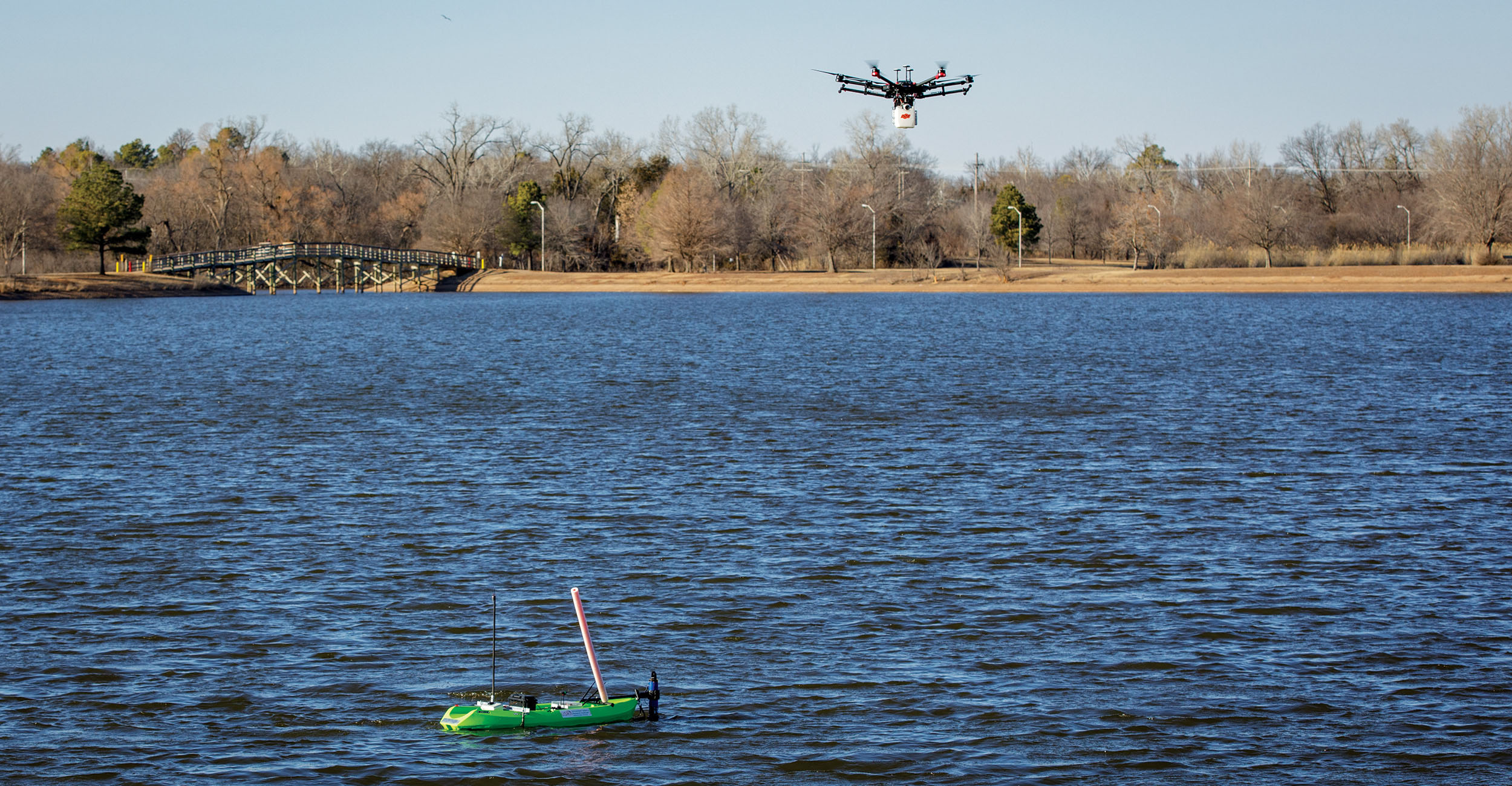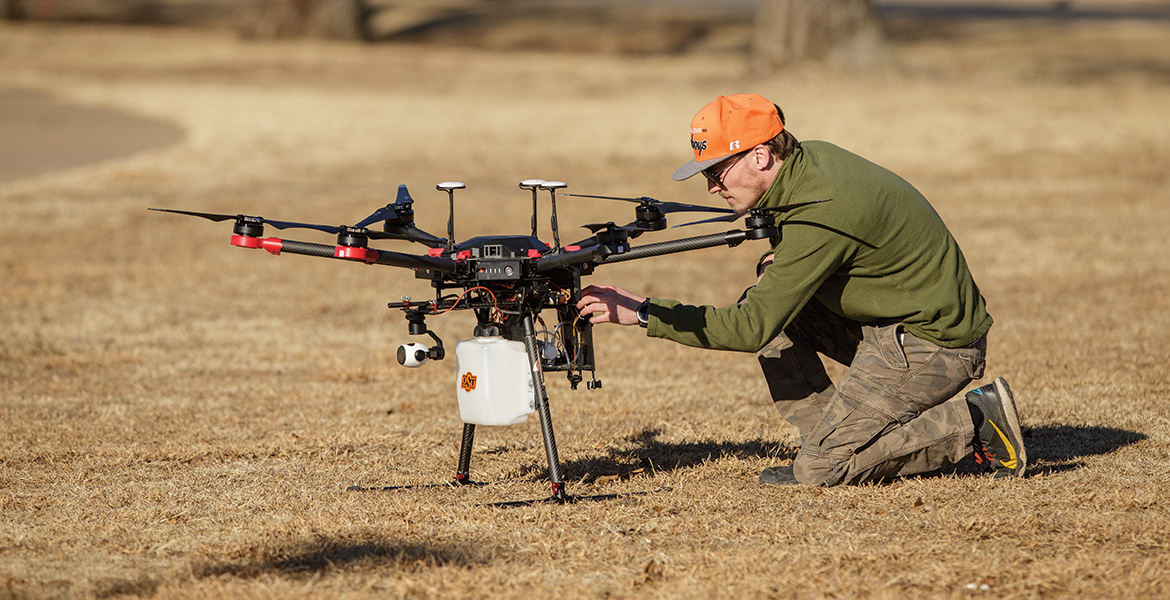
OSU researchers develop innovative method to battle invasive aquatic plants
Wednesday, April 27, 2022
Media Contact: Mack Burke | Editorial Coordinator | 405-744-5540 | editor@okstate.edu
As a modern-land grant university, research that makes a positive impact on the public is key to OSU’s mission. Whether it takes place in labs across campus or fields and lakes around the state and nation, OSU research shapes the future.
Through groundbreaking discoveries and new technologies, OSU is improving lives as researchers are constantly looking for the next innovation.
One area of that highly impactful research includes ensuring Oklahoma’s water supply is safe and accessible.
With over 200 man-made lakes and 11,611 miles of shoreline — more than the non-tidal coasts of the Atlantic Ocean and the Gulf of Mexico combined — water in Oklahoma is a big deal.
Treating, maintaining and monitoring that supply of water is vital to the health of communities across the state — but what happens when the water can’t be reached by boat?
Researchers at Oklahoma State University think the answer lies in drones. Thanks to Stillwater’s Lake Carl Blackwell, they have a testing ground.
In recent years, the lake has faced an infestation of yellow floatingheart — a dense and invasive species that slowly begins to fill the reservoir.
The infestation was bad news for the lake, but OSU researchers saw it as an opportunity for innovation.
“Lake Carl Blackwell sees lots of recreational uses, including: fishing, camping, boating, tubing, skiing, row team, canoeing and kayaking,” said Brian Brinker, Lake Carl Blackwell Park manager. “During times when yellow floating heart was not treated, our coves were unusable for these activities. Over time, it had the potential to decrease water quality.”
Lake Carl Blackwell is unique, though, because it has access to a Tier 1 research university in OSU to help solve these types of problems, Brinker said.

“We first became aware of the yellow floating heart in Lake Carl Blackwell because there were users of the reservoir who were having trouble navigating the coves because this plant had become so dense,” said Dr. Andy Dzialowski, associate professor in the Department of Integrative Biology.
Yellow floating heart is not native to Oklahoma, making it an invasive species, Dzialowski said. And it’s not just limited to Oklahoma — yellow floating heart is causing problems in over 30 states across the nation.
If left untreated, yellow floating heart could displace native plants as well as impact reservoir use and the physical properties of the reservoir — like how much oxygen is available in the water for plants and animals, Dzialowski added.
The team tried a handful of methods to eradicate the plant but were unsuccessful. That is, until they discovered a company making an aquatic herbicide called ProcellaCOR.
“It’s a new type of herbicide that has greatly reduced environmental impacts,” Dzialowski said. “We’re really excited about it based on its low impact on the ecology of the system, its effectiveness on target organisms and the reduced reporting requirements from the Environmental Protection Agency.”
In fact, while it was not required, the team continuously tested the water while applying this product and did not detect any excess chemicals in the environment, Dzialowski said.
After applying the herbicide using an airboat and seeing a 90 percent reduction, the team was confident the herbicide was working. However, it ran into a problem with the areas on the lake that weren’t accessible by boat.

“For example, there was one area that became flooded and there was still some dead vegetation there,” Dzialowski said. “So we started thinking about how else we can access these sites and apply the herbicide to treat the remaining vegetation that we couldn’t treat with a more traditional airboat application.”
That is where the drones flew in.
“One interesting aspect is how you deploy this herbicide, because you do not spray it directly on top of the plant like many other applications,” said Dr. Jamey Jacob, director of OSU’s Unmanned Systems Research Institute.“It needs to be applied at the root of the plant, to initiate the process of killing the invasive species.”
This meant Jacob’s team needed to develop a drone that can take off from the ground, fly to the location and land on water to deploy this herbicide at the plants’ roots. And the drone still needs to operate like a drone, which includes hovering capacity and autonomous flight.
“We want to be able to first fly over and look down with a camera and say, ‘Oh, there’s the yellow floating heart right there,’ and then we have the option of deploying the herbicide from the air, like our deployments last season, or directly through the water,” Jacob said.
The patches unreachable by boat might be small, but they serve as a source for the plant to proliferate.
“One thing that we’ve noticed and has been reported in the literature is that if pieces of this plant break off, they can float away and then they can repopulate or reestablish in other areas of the reservoir,” Dzialowski said.
Treating as much of the lake as possible is crucial to not only Lake Carl Blackwell, but also the surrounding areas.
"Unfortunately, for a lot of invasive species it is really hard to get rid of them once they’re there,” Dzialowski said. “But with yellow floating heart, we can keep chipping away at it and reduce it.”
Drones are a great way to improve the process and reduce the amount of labor intensive work, allowing the invasive species to be better handled, Jacob said, noting that OSU’s methods could be a model for ecologists battling invasive aquatic plants.
“You don’t need three people out there on the boat doing this,” Jacob said. “Now you can take the drone out and reduce the workload and time in the field.”
Jacob mentioned that the autonomous boat and drones will supplement the workers at the lake, not take their place.
“We don’t see this as being a replacement, but it is an augmentation. And in the future, if you catch it early, you can do precision application and may never have to broadly apply the treatment or deploy a manned boat, both which help the environment,” he said.
This drone technology could be used in the future to monitor other bodies of water and apply targeted herbicide treatment.
“I think it’s probably our bread and butter in terms of what we always do with stuff,” Jacob said. “We’re able to define a new application where drones haven’t been used before and say, ‘Oh, here’s a great place to make the world a better place and fulfill our Tier 1 mission for drones.
“But also, we’re using this opportunity as a teaching tool.”
One of those students benefiting from the project is Kelly Hendrix in the environmental
science graduate program.
“One of the most exciting parts of this research is the collaboration we have with the mechanical and aerospace engineering department,” Hendrix said. “Being able to not only have hands-on experience with a real-world problem, but to also be part of a team assessing and developing new techniques has been really fun.”
Outside of just the environmental sciences graduate program, there are other students also working on this issue.
The mercury robotics team is already thinking about the next logical step — an unmanned boat with the drone on board.
“The autonomous boat launches, and when it gets to the point where it needs to deploy, the aerial drone can take off autonomously, complete the mission and come back and land on the boat,” Jacob said.
OSU researchers took a crucial issue at Lake Carl Blackwell and found a way to not only treat it, but also to develop innovative methods using new and emerging technology. That, Jacob said, is at the core of the land-grant mission and showcases the problem-solving power of public-impact research.
“At the end of the day, conducting research out on the water and using drones is just pretty darn cool however you look at it,” Hendrix said.
Photos by: Gary Lawson and Andy Dzialowski
Story by: Harrison Hill | STATE Magazine
